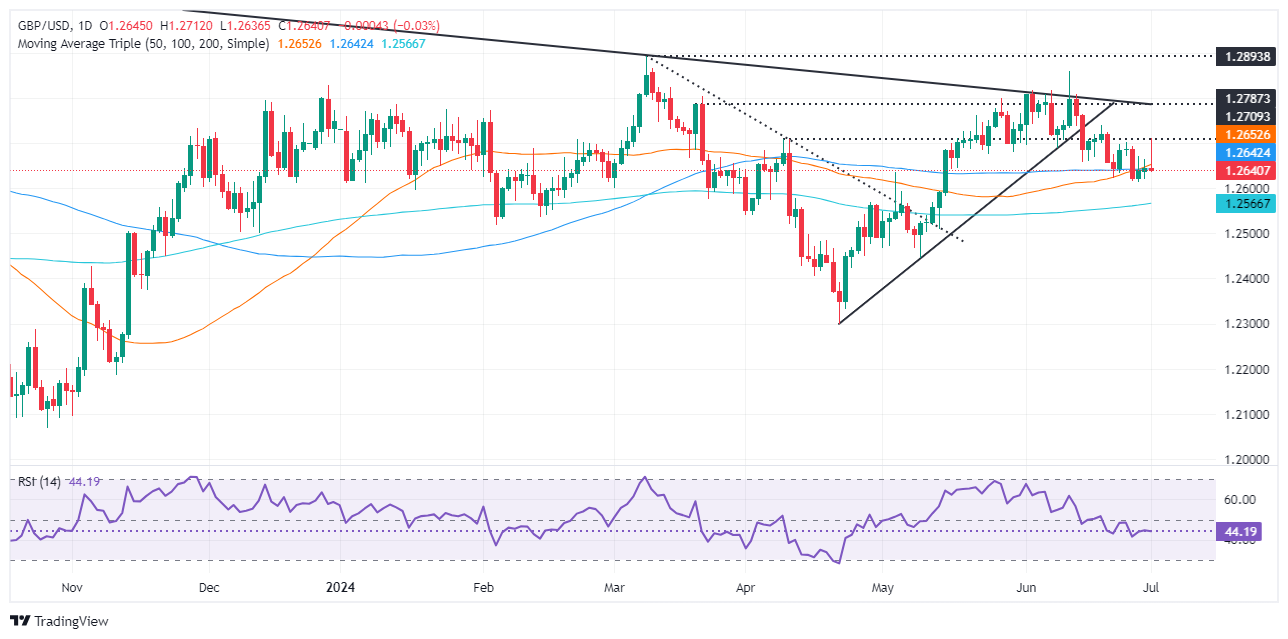- Analytics
- News and Tools
- Market News
- GBP/USD Price Analysis: Erases gains as bears move in post-weak US data
GBP/USD Price Analysis: Erases gains as bears move in post-weak US data
- GBP/USD falls as concerns of potential US recession weigh on markets.
- Technicals suggest neutral to downward bias, marked by lower highs and lows.
- Support levels: 1.2600 (daily MAs), 1.2560 (200-DMA), 1.2500, 1.2445 (May 9 low), 1.2299 (YTD low).
- Resistance points: 1.2700, 1.2750, 1.2800, 1.2868 (June 12 high).
The Pound Sterling erased earlier gains during Monday’s session against the Greenback, even though US economic data showed the economy is slowing down. Per the market’s reaction to the data, it could be seen that worries about a recession in the US loom as US equities tumbled, along with the US Dollar, as market participants await US jobs data on Friday. The GBP/USD trades at 1.2643, down 0.01%.
GBP/USD Price Analysis: Technical outlook
Technically speaking, the GBP/USD is neutral to downward biased, as seen by a successful series of lower and lower lows, dragging the pair from year-to-date (YTD) highs of 1.2894 toward current exchange rates. However, although lagging, the daily moving averages (DMAs) are capping the pair’s downside at around 1.2600, which, once cleared, could pave the way for further downside.
In that event, the GBP/USD next support would be the 200-DMA at 1.2560, followed by 1.2500 ahead of the May 9 cycle low of 1.2445. A breach of the latter will expose the YTD low of 1.2299.
On the other hand, if buyers reclaim 1.2700, the next resistance would be 1.2750. Once hurdle, the next stop would be 1.2800 before challenging the June 12 high of 1.2868.
GBP/USD Price Action – Daily Chart
Pound Sterling FAQs
The Pound Sterling (GBP) is the oldest currency in the world (886 AD) and the official currency of the United Kingdom. It is the fourth most traded unit for foreign exchange (FX) in the world, accounting for 12% of all transactions, averaging $630 billion a day, according to 2022 data. Its key trading pairs are GBP/USD, aka ‘Cable’, which accounts for 11% of FX, GBP/JPY, or the ‘Dragon’ as it is known by traders (3%), and EUR/GBP (2%). The Pound Sterling is issued by the Bank of England (BoE).
The single most important factor influencing the value of the Pound Sterling is monetary policy decided by the Bank of England. The BoE bases its decisions on whether it has achieved its primary goal of “price stability” – a steady inflation rate of around 2%. Its primary tool for achieving this is the adjustment of interest rates. When inflation is too high, the BoE will try to rein it in by raising interest rates, making it more expensive for people and businesses to access credit. This is generally positive for GBP, as higher interest rates make the UK a more attractive place for global investors to park their money. When inflation falls too low it is a sign economic growth is slowing. In this scenario, the BoE will consider lowering interest rates to cheapen credit so businesses will borrow more to invest in growth-generating projects.
Data releases gauge the health of the economy and can impact the value of the Pound Sterling. Indicators such as GDP, Manufacturing and Services PMIs, and employment can all influence the direction of the GBP. A strong economy is good for Sterling. Not only does it attract more foreign investment but it may encourage the BoE to put up interest rates, which will directly strengthen GBP. Otherwise, if economic data is weak, the Pound Sterling is likely to fall.
Another significant data release for the Pound Sterling is the Trade Balance. This indicator measures the difference between what a country earns from its exports and what it spends on imports over a given period. If a country produces highly sought-after exports, its currency will benefit purely from the extra demand created from foreign buyers seeking to purchase these goods. Therefore, a positive net Trade Balance strengthens a currency and vice versa for a negative balance.
© 2000-2024. All rights reserved.
This site is managed by Teletrade D.J. LLC 2351 LLC 2022 (Euro House, Richmond Hill Road, Kingstown, VC0100, St. Vincent and the Grenadines).
The information on this website is for informational purposes only and does not constitute any investment advice.
The company does not serve or provide services to customers who are residents of the US, Canada, Iran, The Democratic People's Republic of Korea, Yemen and FATF blacklisted countries.
Making transactions on financial markets with marginal financial instruments opens up wide possibilities and allows investors who are willing to take risks to earn high profits, carrying a potentially high risk of losses at the same time. Therefore you should responsibly approach the issue of choosing the appropriate investment strategy, taking the available resources into account, before starting trading.
Use of the information: full or partial use of materials from this website must always be referenced to TeleTrade as the source of information. Use of the materials on the Internet must be accompanied by a hyperlink to teletrade.org. Automatic import of materials and information from this website is prohibited.
Please contact our PR department if you have any questions or need assistance at pr@teletrade.global.
















